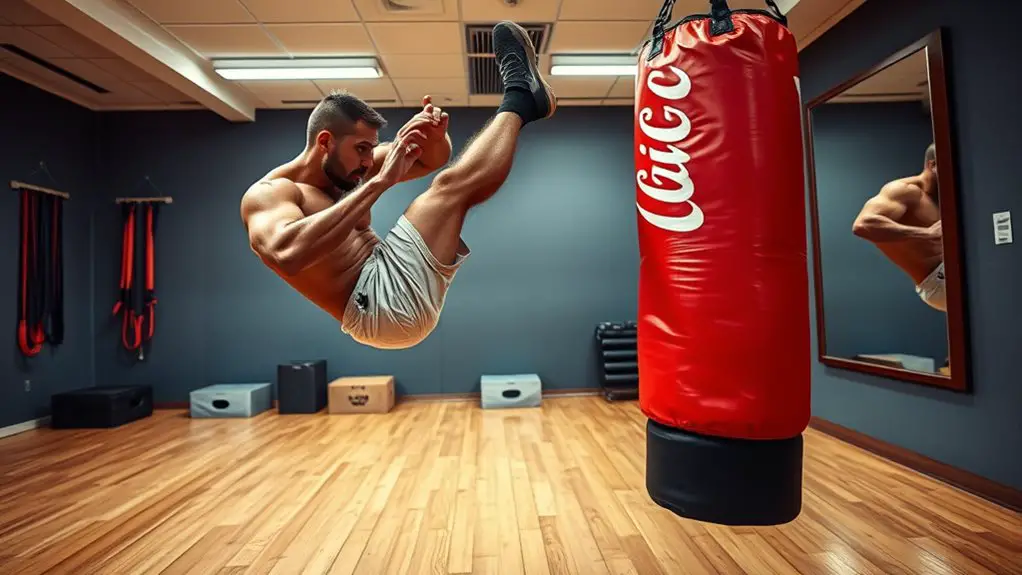The Best Gym Exercises for Kicking Power in Combat Sports

To boost your kicking power in combat sports, focus on a mix of plyometric exercises like box jumps for explosiveness, strength training with squats for muscle stability, and balance drills on unstable surfaces to enhance proprioception. Don’t overlook flexibility work with dynamic lunges and conditioning through cardio intervals to sustain that power throughout a match. Integrating these elements will greatly improve your performance, and there’s even more to explore on effective training routines.
Plyometric Exercises for Explosive Kicking Power

When you focus on enhancing your kicking power, incorporating plyometric exercises into your routine can make a noteworthy difference. These explosive movements generate quick muscle contractions, which translate directly into improved kicking strength. One effective exercise is box jumps. They not only build explosive leg power but also enhance your overall athleticism. As you leap onto a sturdy box, you engage your fast-twitch muscle fibers, essential for delivering powerful kicks.
Another valuable tool is the medicine ball. Utilize it for explosive throws; these mimic the dynamic motion of a kick. For instance, performing rotational throws can develop the core and hip strength vital for executing strong kicks.
Combining these plyometric exercises can greatly amplify your kicking power. Stay consistent and challenge yourself, and you’ll notice remarkable improvements in your performance. Embrace the grind, and soon those kicks will pack the punch you’ve been aiming for!
Strength Training for Leg and Core Muscles
Building on the explosive strength gained from plyometric exercises, strength training for your legs and core is vital to maximizing your kicking power. Incorporating squat variations, like front squats and single-leg squats, helps build muscle and stability in your legs, which directly translates to more powerful kicks.
Additionally, enhancing your core stability is significant; a strong core stabilizes your body during kicks, ensuring force is transferred efficiently. This is particularly important as stiff leg deadlifts can effectively target the hamstrings, contributing to your overall power in kicking.
Here’s a quick overview of the benefits:
| Exercise | Benefit |
|---|---|
| Squat Variations | Increases leg strength |
| Core Exercises | Improves stability & balance |
| Deadlifts | Enhances overall power |
Balance and Stability Drills for Improved Kicking

To truly enhance your kicking power, integrating balance and stability drills into your training regimen is essential. Strong kicks require not just muscle but also precise coordination. By incorporating balance techniques, you’ll improve your control over your body during powerful movements. Exercises like single-leg stands on unstable surfaces challenge your proprioception, forcing your muscles to adapt and stabilize.
Stability exercises, such as the Bosu ball squats, help develop the core strength necessary for maintaining balance while executing kicks. Try combining these exercises with resistance bands to further engage your stabilizing muscles.
Additionally, practicing dynamic movements, like kicking a heavy bag while balancing on one leg, simulates real combat scenarios, enhancing your overall performance. Remember, the more stable and balanced you are, the more powerful and accurate your kicks will become. Stay consistent with these drills, and you’ll notice significant improvements in your kicking prowess.
Flexibility and Mobility Work for Enhanced Range of Motion
Achieving powerful kicks goes beyond just balance and stability; it also hinges on flexibility and mobility. Incorporating dynamic stretching and yoga poses into your routine can greatly enhance your range of motion, allowing for more explosive kicks.
Here’s a quick reference to effective flexibility and mobility exercises:
| Exercise | Type | Benefits |
|---|---|---|
| Dynamic Lunges | Dynamic Stretching | Opens hip flexors |
| Pigeon Pose | Yoga Pose | Stretches glutes and hips |
| High Knees | Dynamic Stretching | Warms up lower body |
| Downward Dog | Yoga Pose | Lengthens spine and legs |
Focusing on these movements not only prepares your body for intense training but also aids in injury prevention. By integrating flexibility work, you’ll reveal greater kicking power, leading to improved performance in your combat sports.
Conditioning and Endurance Training for Sustained Power

While strength and technique are essential for powerful kicks, conditioning and endurance training can make all the difference when it comes to sustaining that power throughout a match. Incorporating cardio intervals into your routine can greatly enhance your stamina, allowing you to maintain explosive kicks even in the later rounds. By alternating between high-intensity bursts and recovery periods, you’ll improve your aerobic capacity and overall endurance. Additionally, jumping rope serves as a full-body workout that can significantly increase your heart rate and calorie burn, making it a fantastic addition to your training regimen.
Circuit training is another effective method to build both strength and conditioning. By combining exercises like squats, lunges, and plyometric drills in a circuit format, you’ll not only enhance your kicking power but also boost your heart rate, keeping your body primed for action. Remember, it’s not just about landing powerful kicks; it’s about maintaining that intensity throughout the fight. Prioritize these conditioning techniques, and you’ll find yourself more resilient and effective in the ring.
Frequently Asked Questions
How Often Should I Perform These Exercises Weekly?
When considering your training frequency, you should aim for about three to four sessions per week. This allows you to build strength and power effectively, while also giving your muscles time to recover, which is essential for growth. Don’t underestimate recovery; it’s just as important as the workouts themselves. Listen to your body, and if you feel fatigued, don’t hesitate to adjust your schedule. Consistency and balance are key to maximizing your results.
What Is the Ideal Warm-Up Routine Before Training?
Before training, you can’t just jump right in; you need to prepare your body. Start with dynamic stretches to increase blood flow and flexibility, then shift to mobility drills to enhance joint movement. This warm-up routine not only prevents injury but also primes your muscles for the intensity ahead. Remember, a proper warm-up can make the difference between a productive session and one that leaves you feeling stiff and unprepared.
Can I Do These Exercises at Home?
Absolutely, you can do these exercises at home! Incorporating bodyweight exercises into your home workout routine can be just as effective. Focus on movements like squats, lunges, and planks to build strength, flexibility, and endurance. It’s not just about the gym; consistency in your home workouts will yield great results. Plus, you can easily adjust the intensity to match your fitness level, making it a perfect option for your training needs.
What Nutrition Supports Kicking Power Development?
To enhance your kicking power, focus on nutrition timing and power foods. Eating carbohydrates before workouts fuels your energy, while protein post-exercise aids muscle recovery. Incorporate lean meats, nuts, and whole grains into your meals for best results. Stay hydrated to maintain performance levels. By timing your nutrition effectively and choosing the right foods, you’ll support your body’s strength and endurance, ultimately improving your kicking power in combat sports.
How Long Until I See Improvements in Kicking Power?
Imagine planting a seed; with proper care, it’ll sprout in time. Similarly, when you focus on kicking technique and strength training, you might see improvements in your kicking power in about 4 to 6 weeks. Consistency’s key—just like watering that seed daily. Track your progress, tweak your routine, and soon you’ll feel the difference. Stay motivated; your hard work will yield powerful kicks that’ll enhance your performance in no time!





